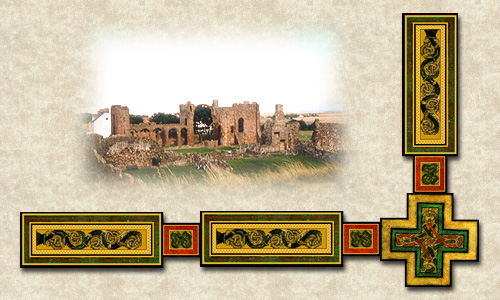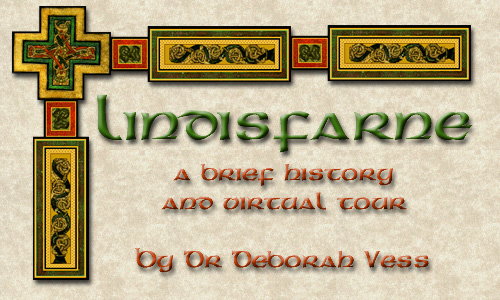
|
CuthbertCuthbert saw a vision of his death and entered Melrose Abbey in Scotland. The abbot there, Eata, had been a pupil of Aidan. Cuthbert helped found a monastery at Ripon, where he was guest master. Bede tells us that, "above all else he was afire with heavenly love, unassumingly patient, devoted to unceasing prayer, and kindly to all who came to him for comfort. He regarded the labor of helping the weaker brethren as equivalent to prayer." Cuthbert later went back to Melrose, where he and others caught the plague including the prior Boisil. In last days of the prior's life at Melrose, they meditated on the Gospel of John. Cuthbert became prior of Melrose in 661. While prior, he showed great concern for plague victims, sometimes leaving for as long as a month. Bede tells of a famous incident of Cuthbert in prayer at the sea at Coldingham where Ebba, sister of Oswald, was abbess. According to Bede, Coldingham was a corrupt establishment which would later be destroyed by fire. While Cuthbert was at prayer there, two Otters rubbed themselves against him and would not leave until he blessed them. This simple story illustrated the harmonization of humans and creatures through the fervent prayer of Cuthbert. After the Synod of Whitby in 664, Eata became bishop of Lindisfarne, taking Cuthbert with him as prior. Cuthbert was about thirty years old at the time. He was known to go for three or four days at a time without sleep.
In 676 Cuthbert resigned as prior to enter more deeply into the hermit's life. He went to the Inner Farne, which was reputed to be a very dangerous place filled with evil sprits. His sojourn there enhanced his reputation for holiness. Despite his retreat, Cuthbert was summoned back to become Bishop of Lindisfarne in 685. Two years later he was brought back to the Inner Farne to die. Monks lit a fire to signal the Holy Island that Cuthbert had died. He was buried to the right of the monastery altar, probably located where the priory now stands.
Cuthbert died in 687 and was elevated in 698. The Lindisfarne Gospels and a beautiful carved coffin were made for this event. When Cuthbert's coffin was opened, his incorrupt body was discovered and many miracles were reported around it. Lindisfarne became an important center for pilgrimage. So important a center was it that some kings became monks there while other kings fled there during times of turmoil for protection. King Ceowulf became a monk in 737; King Offa was dragged from the church half-dead in 756 by his enemies.
|
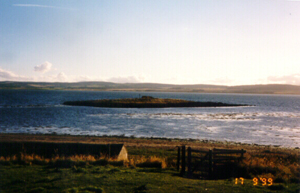 Like
Aidan before him, he was attracted to the hermit's life despite his
love for the people. He often spent time on this tiny island, where
he had a hermitage. This island, like the Holy Island itself, is cut
off twice daily by the tides.
Like
Aidan before him, he was attracted to the hermit's life despite his
love for the people. He often spent time on this tiny island, where
he had a hermitage. This island, like the Holy Island itself, is cut
off twice daily by the tides. 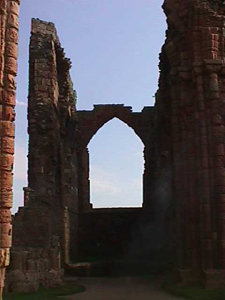 Probable location of Cuthbert's Tomb in the apse of the priory
Probable location of Cuthbert's Tomb in the apse of the priory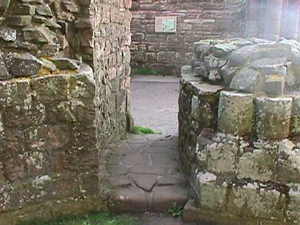 This
picture shows a narrow passage way to the apse of the twelfth-century
priory. This passage might once have been the path pilgrims took to
visit the relics of Cuthbert.
This
picture shows a narrow passage way to the apse of the twelfth-century
priory. This passage might once have been the path pilgrims took to
visit the relics of Cuthbert. 